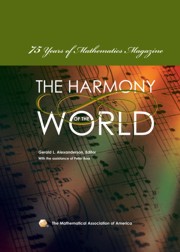Book contents
- Frontmatter
- Introduction
- Contents
- A Brief History of Mathematics Magazine
- Part I The First Fifteen Years
- Part II The 1940s
- Part III The 1950s
- Part IV The 1960s
- Generalizations of Theorems about Triangles
- A Radical Suggestion
- Topology and Analysis
- The Sequence {sin n}
- Probability Theory and the Lebesgue Integral
- On Round Pegs in Square Holes and Square Pegs in Round Holes
- π: 1832–1879
- Part V The 1970s
- Part VI The 1980s
- Briefly Noted
- The Problem Section
- Index
- About the Editors
Topology and Analysis
from Part IV - The 1960s
- Frontmatter
- Introduction
- Contents
- A Brief History of Mathematics Magazine
- Part I The First Fifteen Years
- Part II The 1940s
- Part III The 1950s
- Part IV The 1960s
- Generalizations of Theorems about Triangles
- A Radical Suggestion
- Topology and Analysis
- The Sequence {sin n}
- Probability Theory and the Lebesgue Integral
- On Round Pegs in Square Holes and Square Pegs in Round Holes
- π: 1832–1879
- Part V The 1970s
- Part VI The 1980s
- Briefly Noted
- The Problem Section
- Index
- About the Editors
Summary
Editors' Note: Robert Creighton Buck received his undergraduate education at the University of Cincinnati and his PhD from Harvard in 1947, where his advisor was David Widder. After a short stay at Brown University he moved to the University of Wisconsin in Madison, where he stayed for the rest of his career, becoming department head in 1964.
He chaired the Committee on the Undergraduate Program, 1959–63, for the MAA and was active in the school reform movement, mainly the School Mathematics Study Group (SMSG), 1960–64. He is widely known for his very successful text Advanced Calculus (McGraw-Hill, 1978). Other books include Studies in Modern Analysis (MAA, 1962), for which he served as editor, and, with Ralph P. Boas, Jr., Polynomial Expansions of Analytic Functions (Academic Press, 1964).
Professor Buck died in 1998.
Introduction
In what follows, I speak as an analyst, not a topologist. In particular, I am not discussing topology as an axiomatic structure, nor yet as a touchstone to bring young minds to life, nor as an organized body of theorems. Rather, I shall confine my remarks largely to the role of topology as something which illuminates topics in analysis, and which provides a more geometric viewpoint. I will give a series of unconnected illustrations.
Elementary calculus
To “illuminate” can mean to clarify or simplify. Suppose we assume a background of the simplest anatomy of topology—acquaintance with the meaning of open, closed, connected, compact, etc., all applied chiefly in the context of sets in Euclidean space.
- Type
- Chapter
- Information
- Harmony of the World75 Years of Mathematics Magazine, pp. 117 - 120Publisher: Mathematical Association of AmericaPrint publication year: 2007

